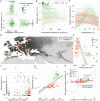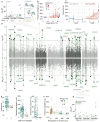This is a preprint.
Rapid adaptation and extinction across climates in synchronized outdoor evolution experiments of Arabidopsis thaliana
- PMID: 40501611
- PMCID: PMC12154770
- DOI: 10.1101/2025.05.28.654549
Rapid adaptation and extinction across climates in synchronized outdoor evolution experiments of Arabidopsis thaliana
Abstract
Climate change is threatening species with extinction, and rapid evolutionary adaptation may be their only option for population rescue over short ecological timescales. However, direct observations of rapid genetic adaptation and population dynamics across climates are rare across species. To fill this gap, we conducted a replicated, globally synchronized evolution experiment with the plant Arabidopsis thaliana for 5 years in over 30 outdoor experimental gardens with distinct climates across Europe, the Levant, and North America. We performed whole-genome sequencing on ~70,000 surviving reproductive individuals and directly observed rapid and repeatable adaptation across climates. Allele frequency changes over time were parallel in experimental evolution replicates within the same climates, while they diverged across contrasting climates-with some allele frequency shifts best explained by strong selection between -46% to +60%. Screening the genome for signals of rapid climate adaptation identified a polygenic architecture with both known and novel adaptive genetic variants connected to important ecological phenotypes including environmental stress responses, CAM5 and HEAT SHOCK FACTORs, and germination and spring flowering timing, CYTOCHROME P450s and TSF. We found evolutionary adaptation trends were often predictable, but variable across environments. In warm climates, high evolutionary predictability was associated with population survival up to 5 years, while erratic trends were an early warning for population extinction. Together, these results show rapid climate adaptation may be possible, but understanding its limits across species will be key for biodiversity forecasting.
Conflict of interest statement
Disclosure statement D.W. holds equity in Computomics, which advises plant breeders. D.W. also consults for KWS SE, a globally active plant breeder and seed producer. All other authors declare no competing financial interests. The funders had no role in study design, data collection and analysis, decision to publish, or preparation of the manuscript.
Figures





References
-
- Landis J. B., Guercio A. M., Brown K. E., Fiscus C. J., Morrell P. L., Koenig D., Natural selection drives emergent genetic homogeneity in a century-scale experiment with barley. Science 385, 2023.09.22.557807 (2024). - PubMed
-
- Enbody E. D., Sendell-Price A. T., Sprehn C. G., Rubin C.-J., Visscher P. M., Grant B. R., Grant P. R., Andersson L., Community-wide genome sequencing reveals 30 years of Darwin’s finch evolution. Science 381, eadf6218 (2023). - PubMed
Publication types
Grants and funding
LinkOut - more resources
Full Text Sources
Research Materials
Miscellaneous
